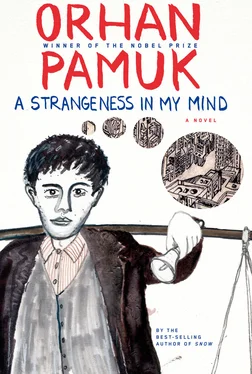In the months to follow, Mevlut would look out the window of his gecekondu home and, as his wife slept, stare pensively at Hadji Hamit’s mosque and all the other hills covered in apartment blocks, trying not to think of Rayiha. In those early months of his marriage, there were occasional moments when he felt he’d already lived that same moment before. He wasn’t sure, though, whether the illusion was on account of having just married again after so many years, or whether it had something to do with being back in his childhood home.
PART VI. Wednesday, 15 April 2009
No good will ever come of negotiating with family on a rainy day.
— Byron Pasha, Apologies and Ironies
The Twelve-Story Building
You Have a Right to the City’s Rent
REMEMBER, you swore, nothing less than sixty-two percent,” said Samiha as she saw her husband out. “Don’t let them intimidate you.”
“Why would I be intimidated by them,” said Mevlut.
“Don’t believe any of Süleyman’s nonsense either, and don’t lose your temper. Have you got the title deed?”
“I’ve got the councilman’s papers,” said Mevlut as he set off down the hill. The sky was heavy with gray clouds. They were all going to meet at Uncle Hasan’s grocery store in Duttepe to review the situation and go through one final round of negotiations. Vural Holdings, the Vurals’ big construction company, was taking advantage of a series of recent urban renewal measures to build sixteen new high-rises in the neighborhood. They’d planned a twelve-story apartment building on the site currently occupied by the one-room house Mevlut had inherited from his father, the home he’d been sharing with Samiha for the past seven years. This meant that Mevlut, like so many others, had to arrive at terms with the Vurals. But he’d been dragging things out and digging his heels in over final points, and now Korkut and Süleyman were angry at him.
Mevlut hadn’t signed the agreement yet; he continued to live with Samiha in his childhood home, even as some of the apartments soon to be built on that land had already been sold. Mevlut would go out into his garden sometimes and point at the sky overhead, marveling at the ridiculousness of those wealthy people who had paid the Vurals in advance for apartments they would one day own “up there.” But Samiha didn’t think there was anything funny about it. Mevlut was always impressed by his second wife’s realism.
A model of the planned building was on display at the Vural Holdings marketing office on Main Street, which ran between Duttepe and Kültepe. A blond woman always in high heels would talk visitors through all the different apartment options on offer and the materials to be used in the bathrooms and kitchens before pausing to mention that all south-facing units above the sixth floor would have Bosphorus views. Even the thought that the Bosphorus could be glimpsed six floors up from the garden of his forty-year-old house was enough to make Mevlut dizzy. Before his final negotiation with the Aktaş family, he went to have one last look at the model.
When news first spread in 2006 that Duttepe and Kültepe, along with many other neighborhoods in Istanbul, had been selected for a large-scale urban redevelopment initiative, and that the government was encouraging high-rise construction in the area, local residents were thrilled. Previously, the law had only allowed three- and four-story buildings on these hills. Now you could build up to twelve floors. People felt as if they were being given bundles of cash. The decision had been handed down from Ankara, but everyone knew that behind it all was Hadji Hamit Vural’s family, who had close ties to the Justice and Development Party (the AKP) and owned many acres across Duttepe and Kültepe. As a result, the governing AKP, which was already popular in the area, had gained even more votes in and around Duttepe and Kültepe. Initially, even those cynics who usually complained about everything kept quiet.
The first murmurs of protest came from the area’s tenants. When it was announced that buildings as high as twelve stories would be allowed, both local rents and the value of land rose sharply, so that people who could barely make it to the end of the month as it was (like Mevlut’s old tenant from Rize) began a gradual exodus from the hills. These long-standing tenants felt just as Mevlut had when he was obliged to leave Tarlabaşı: there was no future for them here, where tall, showy buildings would someday be home to the rich…
The new law stipulated that the site for each twelve-story building would be created by combining lots belonging to as many as sixty existing homeowners. Within a year, the municipality had designated and announced the location of these sites, which split Duttepe and Kültepe into distinct areas. Longtime neighbors, who found out overnight that they would one day be living in the same high-rise, started meeting at one another’s homes, and over tea and cigarettes, they discussed the situation, choosing from among themselves a representative (there were always plenty of aspirants to this position) who could deftly manage any necessary arrangements with the government and the contractors; and soon enough they began to have their first disagreements. At Samiha’s insistence, Mevlut attended three of these meetings. Along with the other men, he was quickly taught all about the concept of “land rent” in economics and how to apply it. Once, he put up his hand and told everyone about all that his late father had been through, how he’d toiled to build the house Mevlut now lived in. But he had trouble keeping up with their discussions about percentages and shares and found relief from that unease at night selling boza out on the solitary streets.
According to the new law, local landowners who wanted an apartment in one of the new high-rises first had to sell their lots to the developer. Other big Turkish concerns had tried to get involved, but Hadji Hamit Vural’s company, which boasted excellent relations not only with the government in Ankara but the neighborhood as well, naturally came out on top. So the owners of the area’s old gecekondu houses began to visit the Vural Holdings offices on Main Street to look at the model in the window, work out what they might expect of their future apartments, and negotiate with Hadji Hamit Vural’s younger son.
At most of the other high-rises that had sprung up all over Istanbul, ownership was usually split fifty-fifty between the developer and the existing homeowners. If a group of locals managed to find a competent representative and act in unison, they could sometimes raise their share to fifty-five percent, or even sixty percent in some cases. This was very rare, however, and it was much likelier that the former gecekondu neighbors would squander their collective advantage by bickering over percentages and move-in dates. Mevlut heard from Süleyman, who always reported these things with a knowing smirk, that some neighborhood representatives were taking bribes from contractors. As both Duttepe landowners and partners in Vural Holdings, Korkut and Süleyman were always up to date with the latest gossip, squabbling, and negotiations.
Most old gecekondu homes had already become proper three- or four-story buildings, and their owners could drive a hard bargain with the state and the developer, as long as they possessed an official title deed. But those like Mevlut, whose only claim to their property was a forty-year-old piece of paper from the neighborhood councilman, and whose house was only a single room (more common than not in Kültepe), were likely to back down if the contractors threatened: “The government might find a way to just take it from you, you know…”
Читать дальше








![Джон Харгрейв - Mind Hacking [How to Change Your Mind for Good in 21 Days]](/books/404192/dzhon-hargrejv-mind-hacking-how-to-change-your-min-thumb.webp)



